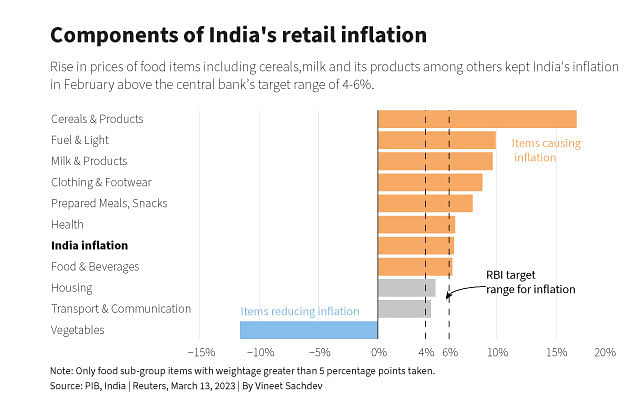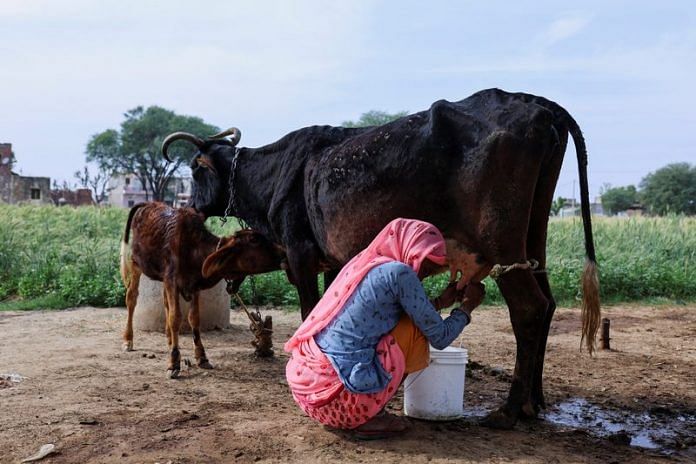Khejri Bujurg (Rajasthan): Buying milk is getting expensive in India and the price could soon hit an all-time high, forcing the world’s biggest producer to step up imports to boost supplies and ease cost of living pressures.
Farmers are wrestling with a rare double whammy: a lethal condition called lumpy skin disease in their cows and a drawdown in market-ready cattle stock after the coronavirus pandemic slowed breeding.
Milk prices have already jumped more than 15% to 56 rupees ($0.68) a litre over the past year – the fastest rise in a decade – making it difficult for the government to bring retail inflation below the central bank’s target.
The soaring prices of milk and other basic goods is expected to become a political issue heading into state elections later this year.
“Any upside risk coming from higher milk prices is going to pose an additional challenge,” said Upasna Bhardwaj, chief economist at India’s Kotak Mahindra Bank.
“Since milk has a weightage of 6.6% in the consumer price index, any spike could have a reasonable implication on headline inflation,” she said.

A 39% jump in exports of dairy products in 2022, followed by lower milk supplies, has already cut inventories of butter and skimmed milk powder (SMP) in India, even as rising incomes lift demand for protein-rich dairy products, a key source of calcium, vitamins and protein for a large vegetarian population.
Industry officials estimate demand for dairy products to rise 7% this year.
But milk production is likely to have risen just 1% in the fiscal year to March 2023, well below the average annual rate of 5.6% in the past decade, said a senior official of the government-backed National Dairy Development Board (NDDB). The official declined be named as he was not authorised to speak to the media.
Imbalances
Ramavatar Sharma, a 57-year-old farmer from Khejri Bujurg village in Rajasthan, a major milk-producing state, is keen to cash in on higher milk prices but is struggling to find affordable cattle.
“Cattle prices have doubled as there are fewer cows in the market,” said Sharma, who has been raising cattle since childhood.
That contrasts with recent years when prices dived in the wake of the coronavirus pandemic. While cows were cheaper, coronavirus lockdowns weighed on milk consumption.
Those losses prevented farmers from increasing herds, which restricted milk stock even during the so-called flush season runs from October to February, when dairies build supply for the lean season.
Farmers and dairy managers say they now have to wait until the next flush season in October to ramp up market-ready cattle stocks and dairy products inventory.
“There is no way we can raise milk production in 2023,” said Santosh Sharma, general manager of Saras Dairy, a leading supplier in Rajasthan.

Devendra Shah, chairman of Parag Milk Foods in Maharashtra state, said the rare surge in milk prices during the flush season has created unusual market pressure, especially in the peak summer months.
“We will witness further rises in milk prices during summer,” Shah said.
Those pressures mean India will rely more on imported SMP, farmers and dairy officials said, further tightening global supplies and setting off a rally in international prices.
India’s SMP imports are likely to hit an all-time high in the fiscal year that started April, surpassing record purchases in 2011-12, dairy industry officials said.
To ease the burden, the government could allow limited duty-free imports of SMP and butter, although it would need to manage volumes to avoid crashing prices, the NDDB official said.
In January, India’s milk and cream imports jumped 1,024% from the last year to $4.87 million, even with import taxes, as dairies increased purchases from France, Germany and Poland.
The temporary removal of those duties would mean imports rise even further, the NDDB official said.
Long-term effects
Lumpy skin disease, which causes blisters and reduces milk production in cows, has infected millions of cattle and killed more than 184,000 in India, including around 76,000 in Rajasthan, according to government data.
Farmers in Rajasthan who managed to protect their cattle through vaccinations now complain about lower incomes as the disease has left them with low-yielding cattle.
“Even the cows that survived after spending a lot of money on medicines and vaccination are now producing less milk than earlier,” Sharma said, pointing to one of his cows with lacerations caused by the disease.
Cattle breeding suffered during pandemic lockdowns due to a shortage of the village-level veterinarians needed to conduct artificial insemination.
The supply problems are already squeezing Indian consumers.
“Just to ensure that our children get milk, we have stopped adding milk to our tea,” said Satyendra Yadav, a Mumbai construction worker. “But any further price rises will make milk out of our reach.”
(Reporting by Rajendra Jadhav; Writing by Mayank Bhardwaj; Additional reporting by Anushka Trivedi; Editing by Sam Holmes)
Disclaimer: This report is auto generated from the Reuters news service. ThePrint holds no responsibilty for its content.



